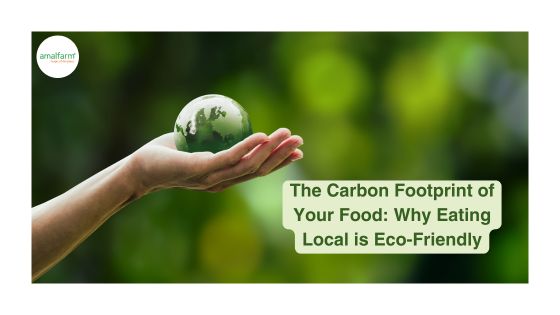Copyright © 2023 Amalfarm. All Rights Reserved.


Have you ever wondered how far your food travels to get to your plate? The answer might surprise you. Food transportation, packaging, and production all contribute to its carbon footprint, and making eco-friendly choices can have a huge impact. One simple way to reduce your carbon footprint is by eating local. Let’s dive into why local food is better for the environment and, ultimately, for you!
Before we dive into the benefits of local food, it’s important to understand what a carbon footprint is. A carbon footprint refers to the total amount of greenhouse gases, such as carbon dioxide and methane, that are released into the atmosphere by a specific product, activity, or person.
When it comes to food, its carbon footprint covers everything from the growing and harvesting of crops to the processing, packaging, and transporting of products. Even cooking the food contributes to emissions. Every stage in the production and distribution chain uses energy, which results in the release of greenhouse gases and contributes to climate change and environmental degradation.

When you buy fruits from another country or meat from halfway across the globe, your food travels thousands of miles to reach your plate. This journey, known as food miles, has a significant impact on the environment. Every mile adds to the carbon footprint of the food, making transportation a key factor in its environmental cost.
Transportation plays a huge role in this. Whether by plane, ship, or truck, moving food across borders burns fossil fuels, which releases greenhouse gases like carbon dioxide into the atmosphere. These gases contribute to global warming, and the farther food travels, the larger its environmental impact becomes. Long-distance food transport can lead to large-scale air, sea, and land pollution.
Packaging is another issue tied to imported food. To keep perishable items fresh during their long journey, they often require extra layers of packaging, much of which is made of plastic. This not only increases waste but also adds to the emissions from producing and disposing of the packaging materials. The more complex the packaging, the larger the environmental footprint.
Additionally, refrigeration and storage play a crucial role in food transportation. Perishable goods like fruits, vegetables, and dairy require controlled environments to stay fresh, often for days or weeks at a time. This extended storage consumes vast amounts of energy, further increasing the carbon footprint of your food.
By understanding how food travels, we can see why cutting down on food miles by eating local makes a positive environmental impact.

Choosing locally grown food is an effective way to reduce carbon emissions because it cuts down the distance your food travels, minimizing its environmental impact. One of the main benefits of eating local is the reduction of food miles—the shorter the distance, the less fuel is burned, which means fewer greenhouse gases are released into the atmosphere.
Another advantage of eating local is that it often encourages consuming seasonal produce. Seasonal foods are grown naturally, without the need for energy-intensive practices like heated greenhouses. This reduces the overall energy consumption in farming and lowers the carbon footprint.
Additionally, local foods usually require less packaging since they don’t need to be preserved for long journeys. With less plastic and waste involved, eating local further minimizes environmental harm. Overall, making the switch to local food is a simple and impactful step toward reducing carbon emissions and living more sustainably.

In addition to being eco-friendly, eating local food directly benefits your community. When you buy from local farmers and producers, your money stays within the region, supporting small businesses and helping them thrive. This creates a more resilient and self-sufficient local economy.
One key advantage is job creation. As the demand for locally grown products increases, more jobs are created in farming, food production, and distribution. This strengthens the economy by providing employment opportunities and boosting community growth.
Another benefit is the freshness and quality of local food. Since it doesn’t need to travel long distances, local produce reaches you faster, meaning it’s fresher and often tastes better. Plus, local foods retain more nutrients because they’re harvested closer to peak ripeness, providing healthier options for you and your family. Eating local not only supports your community but also ensures fresher, better-quality food on your plate
Switching to local food may seem like a small change, but it has a huge impact on the environment and your community. By reducing food miles, cutting emissions, and supporting local farmers, you’re actively contributing to a sustainable future. Every meal offers the chance to shrink your carbon footprint, one bite at a time.
Ready to start your eco-friendly journey? Explore Amalfarm’s range of locally sourced, high-quality products and make a difference today.
Have a question?
